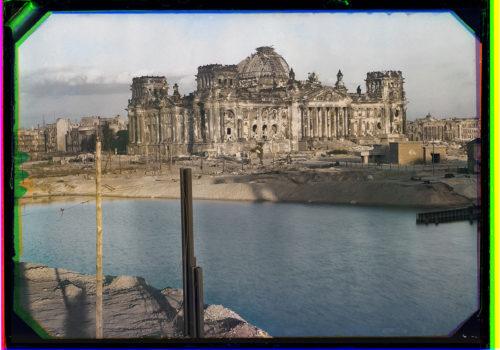We tend to think of Werner Bischof‘s world in black and white. This exhibition, however, is the first comprehensive survey of the Swiss photographer’s work in colour, and it is full of surprises. Nearly one hundred digital colour prints from original negatives dating from 1939 to the 1950s, restored for the occasion, are on show at LAC / MASI, Museo d’arte della Svizzera italiana in Lugano. At a time, when reportage was synonymous with B&W and colour was often considered more suitable for advertising, his use of colour reveals a new, experimental, expressive and, in some ways, transgressive way of photographing.
This expressive idiom accompanied him throughout his career, all over the world. In addition to photographs taken with Leica and Rolleiflex, for the first time, the exhibition presents shots taken with the Devin Tri-Color Camera (on show at LAC), after the discovery of original glass plates by his son, Marco Bischof, who is the director of the Bischof archive. This bulky device, which was based on the colour separation system, was bought for Bischof by the publisher of Du and Zürcher Illustriert magazines and is now preserved at the Swiss Museum of Photographic Equipment in Vevey. The exhibition ranges from the early formal experiments to his studio and fashion shots, from the post-war reportage in Europe to the introspective images of the Far East, from photographic campaigns in the States to his final trip to South America.
Bischof used to be a careful experimenter, having studied with Hans Finsler at the Kunstgewerbeschule in Zurich, and pioneering the “Neue Sachlichkeit” (New Objectivity). With the Second World War, he felt the urge to leave the studio to photograph reality. He documented post-war Europe for the magazine Du. Alongside colour images of Berlin, Cologne, Dresden and other ruined cities, the exhibition includes one of Bischof’s most famous photographs, depicting a boy from Roermond, Holland, whose face was disfigured by scars caused by a German booby trap. Published in colour on the cover of the magazine in 1946, the image provoked an uproar.
The bulky Devin Tri-Color, which required a tripod and intense light, imposed a certain static nature to the image, as in the portraits of rural Italians, where colour, becoming an essential element of the composition, avoids fixity. Shooting with a Rolleiflex 6×6 (late 1940s and early 1950s), Bischof used colour to tell the story of Europe. The expressive use of colour also helped him to capture the spirit of Oriental culture. This is also reflected in the introductory section of the exhibition which includes the book Japon, which alternates black-and-white and colour images and was awarded the Nadar Prize in 1955.
In 1953, on a trip to America, Bischof used his handy Leica to capture the places and people of Central America in vivid photographs with strong colour contrasts. The Leica also accompanied him on his trip to Peru, where he was impressed by the Inca culture and by the light on the ruins. His life was cut short in 1954 by an accident in the Andes during what he called his “Grand Tour”.
It was surprising when Bischop’s son, Marco, came across “several boxes dating to the 1940s which contained hundreds of glass plate negatives. And for each image, there were three apparently identical negatives (…) It turned out that each of the three glass plate negatives for each image presented a different level of intensity. Once overlapped, they formed the colour photograph” (*notes from a conversation between Marco Bischof, Ursula Heidelberger and Rolf Varaguth). For each image in the exhibition, the correct succession of the three plates had to be reconstructed, working with material that was some 90 years old. Once the right combination was found, the negatives were scanned, and (an extremely saturated) colour images appeared. The challenge of the project was the research meant to understand Bischof’s gaze: “We had to rediscover the visual language, the language of those images,” the team explains. In order to do this, some other material from the same period has been studied. In particular, the team looked at the colour covers of the magazine Du the photographer worked for. A huge technical challenge led to the images now on display in the exhibition Unseen Colour, thanks to a partnership between the Werner Bischof Estate and MASI Lugano. The catalogue, with texts by Tobia Bezzola, Clara Bouveresse, Luc Debraine and Peter Pfrunder, is published by Scheidegger & Spiess and Edizioni Casagrande.
Paola Sammartano
Werner Bischof : Unseen Colour
February 12 – July 2, 2023
MASILugano – sede LAC
Piazza Bernardino Luini 6, 6900 Lugano (CH)
https://www.masilugano.ch/en/
https://www.luganolac.ch/
















